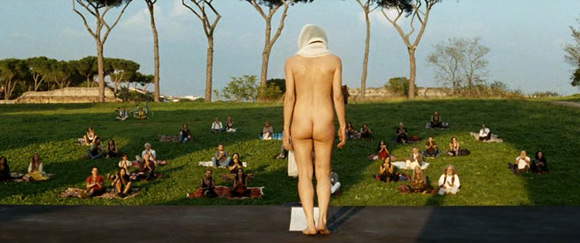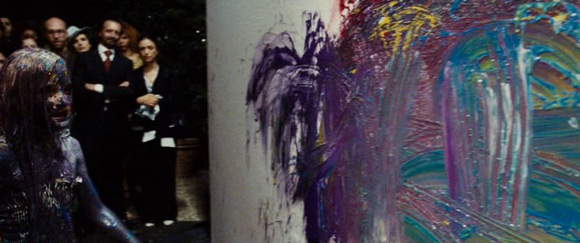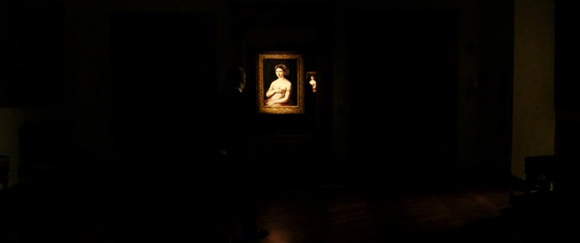"The Great Beauty" by Paolo Sorrentino: a possible reading itinerary between contemporary and ancient art
One of the most interesting scenes in Paolo Sorrentino’s film La Grande Bellezza, which just a few days ago won a Golden Globe and an Oscar nomination, presents itself to the viewer about a quarter of an hour after it begins. It is an artistic performance: the artist, a completely naked woman (whose name we will find out in the following scene: her name is Talia Concept, and she is magnificently played by Anita Kravos), has her head covered with a transparent veil. The camera lingers for a few fractions of a second on her genitals, so that we notice the pubic hair dyed red and on which the image of a hammer scythe has been drawn. At this point the woman takes a run until she slams into one of the arches of theClaudian aqueduct. She falls, gets up, and turns to the audience, shouting “I don’t love myself.” The audience applauds.

Talia Concept’s performance in the film La Grande Bellezza.
In the scene immediately following, the artist, who speaks about herself in the third person, is interviewed by the film’s protagonist, Jep Gambardella, played by a masterful Toni Servillo. The interview is surreal: the artist would like us to talk about the topics she requested, but Gambardella insists on having her explain what she means when she says that her art is inspired by “vibrations, often of an extrasensory nature.” Gambardella’s comment in the face of the artist’s words is lapidary: “she lives by vibrations, but she doesn’t know what they are,” and “Talia Concept talks about things she ignores the meaning of, I only have unpublishable fuffa about her so far.” The artist bursts into tears, confesses that she does not know what she is talking about, and promises to approach her editor to have another journalist sent for the interview.
Those familiar withcontemporary art will find it rather easy to read in Jep Gambardella’s words a critique of contemporary art itself by the film’s authors, and similarly in the artist’s performance they will be able to glimpse the ways of Marina Abramovic, the performer par excellence (in particular, the performance in the film is very reminiscent of the Serbian artist’s Expanding in space ). In Paolo Sorrentino’s film, contemporary art becomes almost the mirror of the society in which Jep Gambardella has condemned himself to live: an empty container, made of appearance and deception, a useless container that has nothing to tell. It is, moreover, Talia Concept herself who declares that she does not know what these “vibrations” are that a few seconds earlier she had referred to as the very essence of her own life (and therefore of her art). And in the perspective of the film, this initial criticism made of contemporary art represents but one of the first realizations that will lead the protagonist on his path that will guide him to great beauty.
Contemporary art then becomes empty, self-referential, a self-congratulatory display of concepts founded on nothing, which nevertheless manage to beguile the most uninformed: a display that, however, dissolves in the face of even the slightest request for dialogue and argumentation. This is the reality of contemporary artists speaking in front of silent, cheering audiences: but who knows what would become of contemporary art if in every audience there were a Jep Gambardella ready to goad the Cattelan or Paladino of the day (just to name two names known to most, Italians, and exalted by an increasingly less incisive criticism) with questions about the essence of their art.
That of the film is a critique that moves not only toward the protagonists of contemporary art (the artist, precisely, and the public), but also toward the world around us, and exemplary in this sense is the scene of little Carmelina, an enfant prodige forced to paint against her will and brutally snatched from games with her little friends to perform in front of one of those silent and acclaiming audiences mentioned earlier, with the slimy condescension of her parents. And the little girl will vent her frustration in front of a canvas against which she will throw cans of paint, crying and smearing herself, but eventually creating a “masterpiece” that will be sold to a wealthy art dealer. It is Carmelina’s own father who tells the little girl, “If you show what you can do, our family will be a happy family.”

Carmelina vents her frustration as she creates her painting, in front of an impassive audience
It is a voracious and cynical market, that of contemporary art, ready to exploit even a little girl, aided by characters of dubious morality who remain impassive in the face of the little girl’s discomfort: it makes one think that the only one who notices the discomfort is Ramona, played by Sabrina Ferilli, a straightforward, simple (and for this reason, we might think, pure) stripper, who points out to Jep that the little girl, while creating her work, is crying. And the response is cynical: “that little girl makes millions.”
But it is precisely on this debacle that asalvific art is grafted that elevates the film’s protagonists from the vulgarity in which they have wallowed up to that moment. It is not, however, contemporary art, or at least not that empty contemporary art, sick of protagonism, hailed by critics and supported by the market: instead, it isancient art, which is subtly revealed by candlelight, in total silence, when Jep takes Ramona on a tour of Rome’s most beautiful palaces, at night, with only the guidance of a friend who holds a candelabra. And it is during this “tour” that there appears, almost as if it were a Madonna, the image of Raphael’s Fornarina: Jep Gambardella stops in front of it, admires it, and then sits for a moment to reflect.

Jep Gambardella admires Raphael’s Fornarina.
Of the many artistic quotations that can be found in the film, this one is probably the most important, because it establishes a parallel between the work and the protagonist, and it is not far-fetched to consider precisely Raphael’s Fornarina, in this appearance, one of the keys to trying to understand the meaning of the film: of course, this is only an interpretation. It is well known that, according to tradition, the Fornarina was Raphael’s beloved woman, Margherita Luti, the daughter of a baker: we have no certain news about the relationship, but it has always stimulated the imagination of the artists exalted by Raphael’s “myth” (one above all, Ingres). Evidently Paolo Sorrentino also knows the story behind the painting, and the detail of the Fornarina therefore may not be accidental, for two main reasons.
The first: Margherita Luti was also an inspirational muse for Raphael, obviously taking for granted a very romantic and very suggestive hypothesis, which, however, would almost seem to be corroborated by the somatic features of several protagonists of the paintings of the last phase of the Urbino painter’s career (think of the Sistine Madonna, the Veiled Madonna, theEcstasy of Saint Cecilia, the Madonna of the Chair). Similarly, we glimpse in the film the presence of an inspirational muse of Jep Gambardella, the woman who inspired his first (and only) novel: this is Elisa, Jep’s fiancée when the latter was eighteen years old, the first girl with whom he made love and above all the one true, great love of his life. In a flashback at the film’s finale, we see their first meeting, under the lighthouse on theIsle of Giglio, where the protagonist will return almost fifty years later: the girl undresses in front of a young Jep, remaining with bare breasts, just like the Fornarina in the painting at Palazzo Barberini.
We learn in the course of the film that the two later broke up, but we do not know why. But it is perhaps because of the lack of true love (and thus true feelings) that Jep will no longer be able to produce anything, so much so that he confesses to his maid (the only character in the film, along with Ramona and an old missionary whom he will meet in the last part, who seems to inspire pure feelings in Jep: here, too, we must remark the fact that this ability comes precisely from the most “humble” characters), in reference to yet another worldly party he is giving on his large terrace overlooking the Colosseum, that “this is my life: and it is nothing.”
The second reason: if we think of this love between Raphael and Margherita, we have to imagine it as a pure and simple love, like Jep Gambardella’s love for Elisa. And it is around this youthful love that the meaning of the film probably develops: the great beauty is not that of unbridled fun, parties, worldliness and luxury, but it is that of pure feelings. Which are those that truly fill life, together, clearly, with art, when the latter becomes the bearer of elevated, though simple, meanings.
Warning: the translation into English of the original Italian article was created using automatic tools. We undertake to review all articles, but we do not guarantee the total absence of inaccuracies in the translation due to the program. You can find the original by clicking on the ITA button. If you find any mistake,please contact us.



























